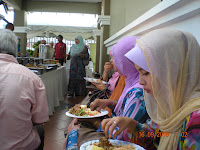INTRODUCTION
For my book, The Early Malay Doctors (TEMD), the word "Malay" is all encompassing. It includes all Muslims, regardless of ethnic origin. So, "Malay" would mean: a label to include all who eat mainly rice as their staple (nasi putih, nasi biryani) either with their right hand/fork & spoon/chopsticks, or breads as alternative (roti canai, roti jala, murtabak) and sometimes noodles (mi goreng, mi bandung, spaghetti) and wear clothes according to their various cultures and customs, covering most parts of their torso, that go to show modesty rather than revealing clothes. So a Malay may appear very Chinese, very Indian, very Orang Asli, very Mat Salleh, very Black, very Melayu, to the moderate not so Chinese, not so Indian, not so Orang Asli, not so Mat Salleh, not so Black, not so Melayu, to pan-Asian features.
 |
| A Malay wedding reception |
The JHEOA describes the Orang Asli (Orang Asal) here: Jabatan Hal Ehwal Orang Asli
The book by Isabella Bird, "The Golden Chersonese: Travels in Malaya" in 1879 is available online and is hosted by Digital Library at http://digital.library.upenn.edu/women/bird/chersonese/chersonese.html#IX.
There is mention of the people who make up the population in Malacca, Penang (Pinang) and Singapore at the time of her visit.
The Malays
She described the Malays as follows: "The people lead strange and uneventful lives. [....] They seclude their women to a great extent, and under ordinary circumstances the slightest courtesy shown by a European man to a Malay woman would be a deadly insult; and at the sight of a man in the distance the women hastily cover their faces.
Singapore Census 1881
For the Singapore census of 1881, the people were grouped as: Europeans and Americans, Eurasians, Chinese, Malays and other natives of the Archipelago, Tamils and other natives of India, and Other nationalities. The Arabs were not categorised with the Malays. Among the Europeans, the Germans were next largest after the British. It mentioned Manilamen instead of Filipinos.
Europeans and Americans 823
Eurasians 930
Chinese 32,194
Malays and other natives of the Archipelago 6,954
Tamils and other natives of India 637
Other nationalities 559
The European resident population, exclusive of the soldiers, is only 1,283. The Europeans comprise 19 nationalities, including the British (largest) and Germans (second largest).
The Chinese population is 86,766; the Malay, 22,114; the Tamil, 10,475; the Javanese, 5,881; and the Eurasian, 3,091.
"Malays and other natives of the Archipelago" included, Achinese, Boyanese, Bugis, Dyaks, Jawi-Pekans, and Manilamen.
"Other nationalities" included Arabs.
Settlement of Malacca Census 1881
The total population of the territory is 93,579 (52,059 males and 41,520 females), an increase in ten years of 15,823. The Chinese population has increased by 6,259 or 46.4 per cent., and the Malays by 11,264, or 19.3 per cent.
European 32 (23 males and 9 females)
Eurasian (mainly of Portuguese mixed blood) 2,213
Chinese 19,741 (4,020 being females)
Malay 67,488 (the females being 2,000 in excess of the males)
Tamils or Klings 1,781
Arabs 227
Aborigines of the Peninsula 308
Javanese 399
Boyanese 212
Jawi-Pekans 867
Other 174 (stray Achinese, Africans, Anamese, Bengalis, Bugis, Dyaks, Manilamen, Siamese, and Singhalese)
Natives of India 42%
Other nationalities 48.9%
The town of Malacca contains 5,538 houses, and the country districts 11,177. The area of the settlement is 640 square miles, and the density of the population 146 to the square mile; only twelve of the population are lunatics.
Penang Census
- there is mention -
















0 comments:
Post a Comment